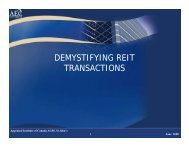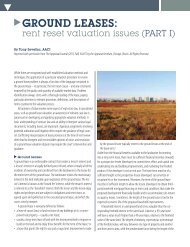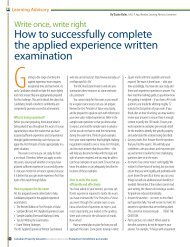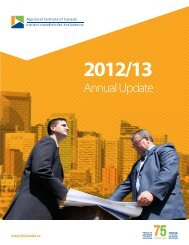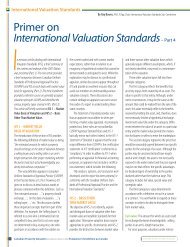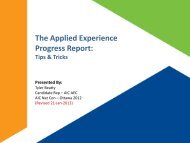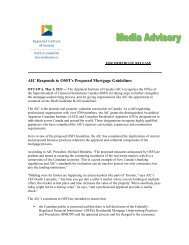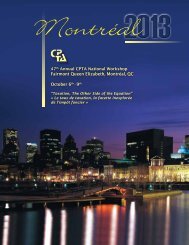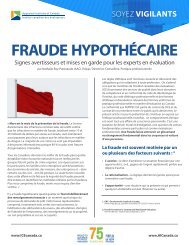Book 1 - Appraisal Institute of Canada
Book 1 - Appraisal Institute of Canada
Book 1 - Appraisal Institute of Canada
You also want an ePaper? Increase the reach of your titles
YUMPU automatically turns print PDFs into web optimized ePapers that Google loves.
MEMBER PROFILE<br />
a step, but, if you cannot do the<br />
99 steps before that, then you will<br />
struggle at completing the final one.<br />
I have concluded that it is important<br />
for people to start by developing<br />
a solid grasp <strong>of</strong> the first 30 steps.<br />
Then, the next 70 are much easier<br />
for them to do.”<br />
Because ‘assistants’ do not<br />
provide significant pr<strong>of</strong>essional<br />
assistance, they do not need to sign<br />
their names to appraisals or to be<br />
insured and registered as candidates<br />
with the <strong>Institute</strong>. In fact, the AIC<br />
has recently created a non-insured<br />
Student Membership category which<br />
supports programs such as Dybvig’s.<br />
When hiring trainees, Grover,<br />
Elliott & Co. looks for people with<br />
analytical skills and an undergraduate<br />
degree, who are taking or<br />
are interested in taking appraisal<br />
courses. “I want somebody who<br />
shows passion for the work,” says<br />
Dybvig, adding that he will choose<br />
someone who enjoys going to open<br />
houses and reads the business section<br />
<strong>of</strong> the newspaper over someone<br />
who does not. “When I was a candidate,<br />
most people got into appraising<br />
as a second or third career. Now,<br />
many people get into it while they<br />
are still in university. That is a positive<br />
thing. The earlier you can get<br />
them and the lower the level you can<br />
bring them in at, the quicker they<br />
are going to be productive.”<br />
Dybvig also has some advice for<br />
young people thinking <strong>of</strong> entering<br />
the pr<strong>of</strong>ession. “They need to make<br />
sure they understand the educational<br />
and other requirements,” he<br />
says. “This can be a lot <strong>of</strong> work.” To<br />
learn about real estate, he suggests<br />
people interested in appraising start<br />
by doing such simple things as reading<br />
the real estate section <strong>of</strong> their<br />
local newspapers and visiting the<br />
properties described. Or, they can go<br />
to their municipal web site and learn<br />
about planning land use controls in<br />
their community. They can also read<br />
market reports available on web<br />
sites for local residential and commercial<br />
brokerages and go to see<br />
the properties and neighbourhoods<br />
discussed therein.<br />
“Then, if you are still serious, take<br />
courses,” he continues. “Employers<br />
prefer serious applicants who have<br />
completed some <strong>of</strong> the classes to<br />
others who have not. And, if you<br />
do not yet have a degree, the best<br />
one to get is a business degree that<br />
makes you eligible for the AIC/UBC<br />
Post Graduate Certificate Program.”<br />
Dybvig requires anyone he hires<br />
to give the company a three-year<br />
commitment. Another one <strong>of</strong> his<br />
best practices is to require everyone<br />
joining Grover, Elliott and Co. to<br />
have taken the Standards and Ethics<br />
Seminar before starting work with<br />
the company. As they progress, they<br />
train any incoming appraisal assistants.<br />
When they finish their course<br />
load, they register as candidates and<br />
become junior appraisers under the<br />
primary supervision <strong>of</strong> three senior<br />
AACIs in the <strong>of</strong>fice. “Then, it is up to<br />
the supervising appraiser to ensure<br />
that the candidates work within the<br />
standards in everything they do,”<br />
says Dybvig.<br />
To assure the public that candidates<br />
who co-sign reports are<br />
provided appropriate guidance and<br />
supervision, <strong>Institute</strong> policy provides<br />
requires designated members to register<br />
four candidates only. However,<br />
this ratio has proven to be challenging<br />
for a company such as Grover,<br />
Elliott, where candidate training and<br />
supervision is spread out over a<br />
number <strong>of</strong> AACIs.<br />
Dybvig appreciates the great<br />
advances the <strong>Institute</strong> has made<br />
in educating and grooming future<br />
appraisers. He notes that trainees<br />
and candidates continuously find<br />
similarities between case studies in<br />
courses and the work that takes place<br />
in the <strong>of</strong>fice. He also reflects on the<br />
great strides made since he trained<br />
as an appraiser in the early 1970s:<br />
“Today, I do not think you could find<br />
a valuation organization that has a<br />
better connection with its education<br />
and actual practice in the field.”<br />
His advice to employers is to<br />
maximize on the excellent training<br />
provided to today’s candidates.<br />
On the other hand, he cautions<br />
that bringing on a candidate is not<br />
necessarily “for everybody.” “It is a<br />
long-term commitment,” he explains.<br />
“You have to be prepared to invest<br />
time in people. But, if you do it, the<br />
youthful enthusiasm is a real asset.”<br />
Be an author for the Canadian Appraiser<br />
Canadian Appraiser magazine is one<br />
<strong>of</strong> the <strong>Appraisal</strong> <strong>Institute</strong> <strong>of</strong> <strong>Canada</strong>’s<br />
most effective tools for communication<br />
with and between members. Every<br />
issue is distributed <strong>Canada</strong>-wide to<br />
the <strong>Institute</strong>’s entire membership<br />
<strong>of</strong> AACIs, CRAs and Candidates. An<br />
expanded distribution and subscription<br />
list extends the reach <strong>of</strong> this magazine<br />
to <strong>Institute</strong> members’ clients, affiliate<br />
organizations and libraries.<br />
Through content licensing<br />
arrangements Canadian Appraiser<br />
articles are made available to<br />
researchers and students by way <strong>of</strong><br />
various research libraries’ electronic<br />
databases. As well, all articles are<br />
posted on AIC’s web site where they<br />
are fully available to Internet users via<br />
popular search engines.<br />
In addition to regular features dealing<br />
with such significant initiatives as<br />
continuing pr<strong>of</strong>essional development,<br />
standards, liability insurance,<br />
communications and pr<strong>of</strong>essional<br />
practice, each issue also provides<br />
a venue for members to share their<br />
knowledge, expertise and experience by<br />
contributing articles they have written<br />
on timely and informative appraisalrelated<br />
topics.<br />
The CPD Program allows for<br />
members to earn a maximum <strong>of</strong> 40<br />
credits for authoring articles throughout<br />
the 5-year cycle. Credits should be<br />
reported on the basis <strong>of</strong> one credit per<br />
hour required to author the articles.<br />
If you are interested in contributing<br />
an article, please contact Joanne<br />
Charlebois, AIC’s Director <strong>of</strong><br />
Communications at (613) 234-6533<br />
ext. 224 or joannec@aicanada.ca<br />
22<br />
C a n a d i a n<br />
Appraiser<br />
Volume 51 • book 1 • 2007<br />
Evaluateur<br />
C a n a d i e n



